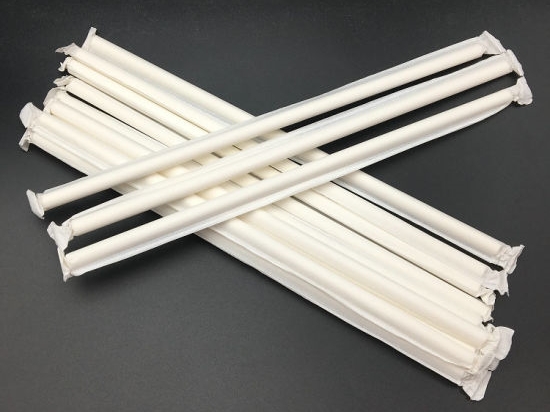What is Paper Straw?
A paper straw is a biodegradable alternative to traditional plastic straws, designed to mitigate environmental pollution. Globally, over 500 billion plastic straws are discarded annually, taking up to 500 years to decompose. In contrast, paper straws degrade in 3–6 months under natural conditions. Notably, straw wrapping paper—a specialized material made from crop residues like wheat, rice, or corn stalks—is distinct from conventional wood pulp paper. Its shorter, densely packed fibers (averaging 0.5–1.5 mm in length) provide unique mechanical properties, such as enhanced flexibility and liquid resistance, making it ideal for sustainable packaging and disposable products.
What is Paper Straw Made of?
Straw wrapping paper is primarily composed of agricultural residues (85–90%) and food-grade additives (10–15%):
Core Materials
-
Cellulose (40–50%): Provides structural integrity and tensile strength.
-
Hemicellulose (20–30%): Enhances water resistance and flexibility.
-
Lignin (10–15%): Naturally binds fibers but is reduced to <5% during processing to improve biodegradability.
Functional Additives
-
Food-safe coatings: Water-based acrylic resins (FDA 21CFR 175.300 compliant) create a hydrophobic barrier, maintaining integrity for 4–8 hours in liquids.
-
Natural binders: Starch-based adhesives ensure recyclability and compostability.
-
Mineral fillers: Calcium carbonate (5–8%) improves smoothness and opacity.
Advanced production techniques, such as enzymatic pretreatment, break down lignin without harsh chemicals, preserving fiber quality while meeting EU EN 13432 compostability standards.

Production Process of Paper Straw
The manufacturing of straw wrapping paper involves five critical stages:
Stage 1: Raw Material Preparation
-
Cleaning: Stalks are washed to remove soil and impurities (residual ash <0.5%).
-
Steam Explosion: High-pressure steam (180–220°C) bursts fiber bundles, reducing lignin content from 18% to <5%.
Stage 2: Pulping
-
Oxygen Delignification: A closed-loop system processes fibers with oxygen and alkali (pH 10–12), achieving a COD (Chemical Oxygen Demand) of <50 mg/L in wastewater.
-
Refining: Fibers are mechanically treated to a Canadian Standard Freeness (CSF) of 300–400 mL, optimizing drainage and sheet formation.
Stage 3: Papermaking
-
Multi-Layer Formation: A triple-layer structure (top: 15 gsm, middle: 30 gsm, bottom: 15 gsm) ensures longitudinal tensile strength ≥8 kN/m.
-
Drying: Infrared drying at 120–150°C removes moisture while preserving fiber elasticity.
Stage 4: Surface Treatment
-
Nano-Coating: A silica-based layer (particle size: 20–50 nm) increases water contact angle to 105° (vs. 75° for untreated paper).
-
Calendering: High-pressure rollers create a smooth surface (Roughness: 1–2 μm).
Stage 5: Straw Forming
-
Spiral Winding: Automated machines wrap paper around mandrels at 3,000 straws/minute, with diameter precision of ±0.1 mm.
-
Cutting: Laser-guided systems ensure consistent lengths (20 cm ±0.5 mm).
Features of Straw Wrapping Paper
Environmental Performance
-
Biodegradability: 90% degradation within 90 days (OECD 301B test).
-
Carbon Footprint: 1.2 kg CO₂/kg paper (vs. 2.5 kg CO₂/kg for plastic).
Mechanical Properties
-
Wet Strength: 4.5 kN/m (survives 8-hour immersion in 40°C liquids).
-
Puncture Resistance: 150 N/mm² (exceeds ASTM D6198 for food packaging).
Safety Compliance
-
Heavy Metals: Lead/Cadmium content <0.005 ppm (meets EU Toy Safety Directive 2009/48/EC).
-
Migration Tests: <10 mg/kg total extractables (FDA 176.170).
Economic Advantages
-
Cost Efficiency: Raw material cost is 120/ton(vs.600/ton for wood pulp).
-
Yield: 1 ton of straw produces 0.65 tons of paper (85% utilization rate).
Applications of Straw Wrapping Paper
Food & Beverage Industry
-
Heat-Resistant Cup Sleeves: Starbucks’ straw paper sleeves withstand 90°C for 2 hours.
-
Edible Food Trays: McDonald’s pilot-tested 100% compostable burger boxes in 2023.
E-Commerce Packaging
-
Cushioning Material: Amazon’s "Frustration-Free Packaging" uses molded straw paper inserts with 25% higher shock absorption than EPS foam.
Advanced Materials
-
Hybrid Composites: Straw paper-PLA laminates are used in IKEA’s biodegradable cutlery (melting point: 160°C).
-
Construction: Germany’s "Strohboard" (straw-based panels) achieve fire rating Class B1 and thermal conductivity of 0.055 W/m·K.
Cultural Innovations
-
Eco-Friendly Stationery: Muji’s straw paper notebooks feature 80% post-consumer recycled content.
-
Art Installations: The 2022 Milan Design Week showcased straw paper sculptures with 92% light transmittance.
Conclusion
The global straw wrapping paper market is projected to reach $4.7 billion by 2027 (CAGR 11.8%), driven by stringent plastic bans in 130+ countries. China alone generates 900 million tons of crop straw annually—if 30% were converted to paper, it could save 72 million trees yearly. From farm fields to urban cafes, this innovation bridges agriculture and industry, proving that sustainability and functionality can coexist. As tech giants like Apple adopt straw paper for product packaging, the material is no longer a niche alternative but a cornerstone of the zero-waste future.































